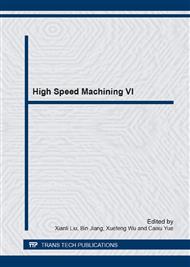p.398
p.402
p.408
p.417
p.424
p.430
p.435
p.440
p.446
Edge Preparation on Cutting Force, Cutting Temperature and Tool Wear for Hard Turning
Abstract:
The paper investigates the effects of cutting edge preparation on cutting force, cutting temperature and tool wear for hard turning. An optimized characterization approach is proposed and five kinds of cemented tools with different edge preparation are adopted in the simulations by DEFROM-2DTM. The results show that both the forces and cutting temperature on the rake face climb up and then declines with the increasing of factor K (Sγ/Sα). While the temperature on flank face decrease with the increasing of the factor K. When the cutting conditions are identical, flank wear reduces while crater wear exacerbates before easing with the increasing of the factor K. The simulation results will provide valuable suggestions for optimization of cutting edge preparation for hard turning in order to obtain excellent machining quality and longer tool life.
Info:
Periodical:
Pages:
424-429
Citation:
Online since:
July 2014
Authors:
Price:
Сopyright:
© 2014 Trans Tech Publications Ltd. All Rights Reserved
Share:
Citation:


